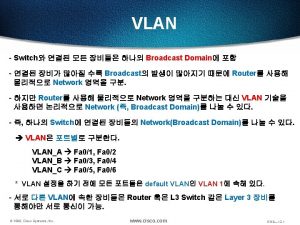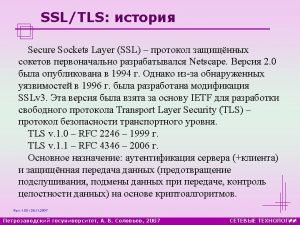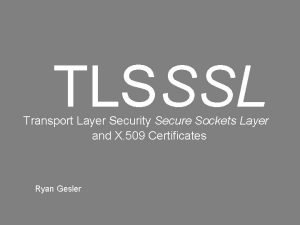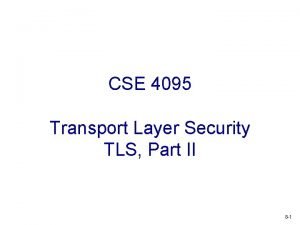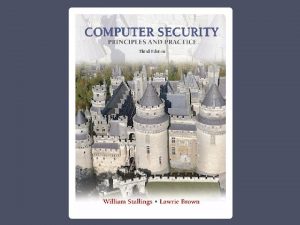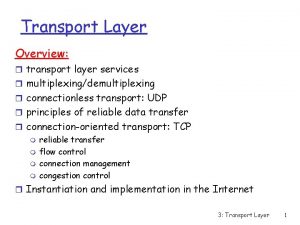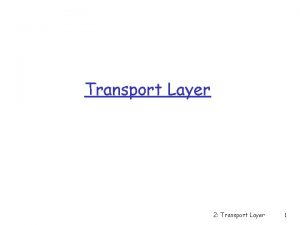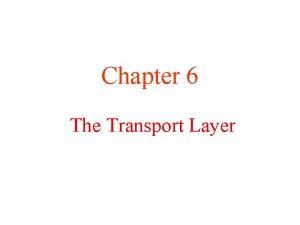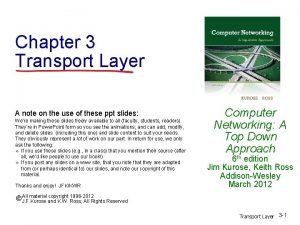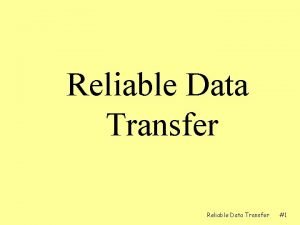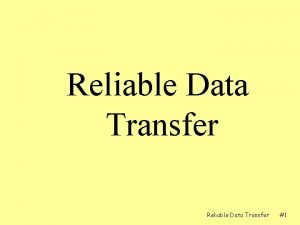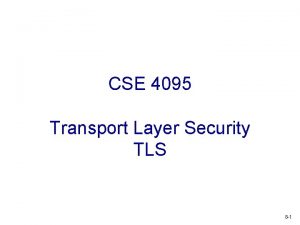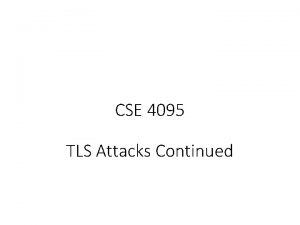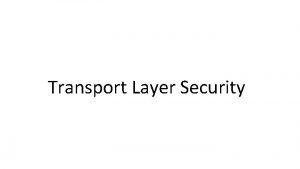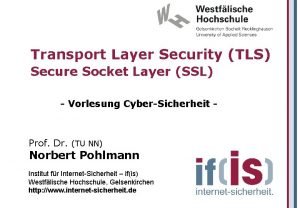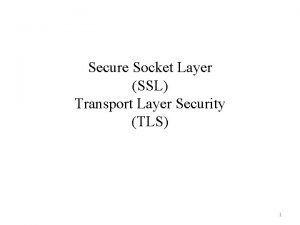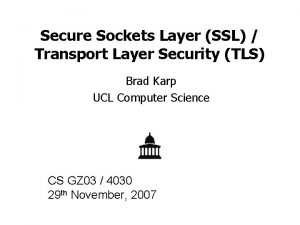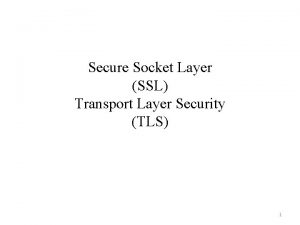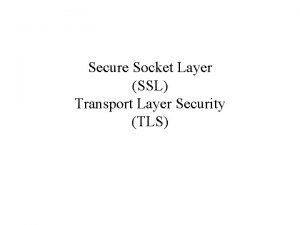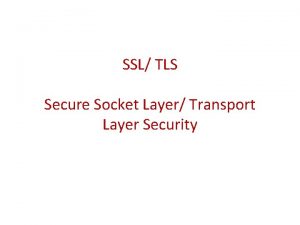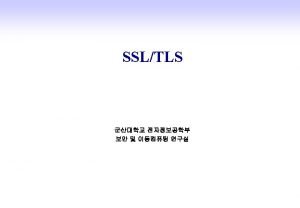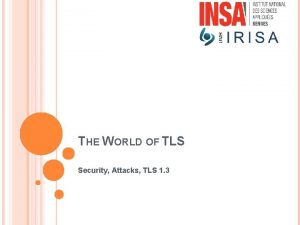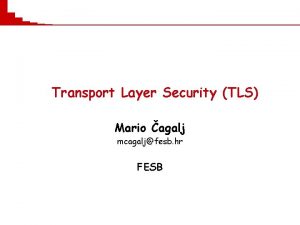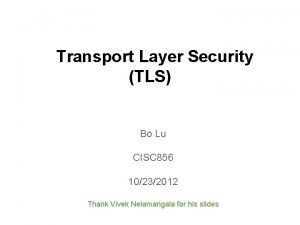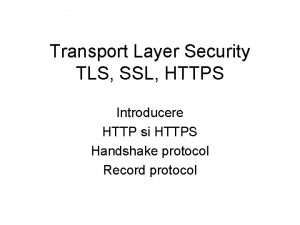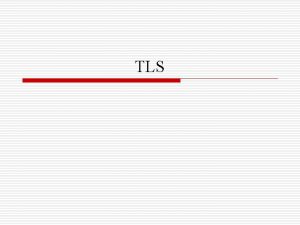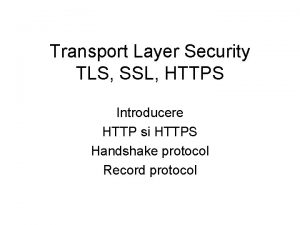CSE 4095 Transport Layer Security TLS Part II
























- Slides: 24

CSE 4095 Transport Layer Security TLS, Part II 8 -1

Handshake Protocol Diagram 8 -2

Recall handshake protocol v. Client. Hello v. Server. Hello, Certificate*, Server. Hello. Done v. Client. Key. Exchange, Finished v. Finished from server side 8 -3

TLS: sharing session keys v. Session key: used only for a session and then discarded v. Use asymmetric ciphers to exchange or generate keying materials to derive session keys v. Key exchange § Client uses asymmetric encryption to send a pre-master secret securely to the server v. Key generation § Two sides exchange unencrypted components; both then derive symmetric session 8 -4

Key exchange 8 -5

Key generation 8 -6

Perfect forward secrecy vcompromising server’s private key would not compromise past sessions v. Difficult to achieve for RSA § Pre-master key encrypted by server’s private key, and is sent over network v. DH with ephemeral key § session keys for past sessions are the only keys that will decrypt the session’s data § Keys not transmitted over network 8 -8

Summary of key exchange/generation v. Three ways: § RSA § DH long-term keys § DH ephemeral keys: provides perfect forward secrecy 8 -9

Sever. Key. Exchange v sent by the server only when the server Certificate message (if sent) does not contain enough data to allow the client to exchange a premaster secret v will be sent immediately after the server Certificate message (or the Server. Hello message, if this is an anonymous negotiation (not recommended in practice)) 8 -10

Sever. Key. Exchange (cont’d) Signature is used to verify identity of server 8 -11

Client certificate v Only sent if the server requests a certificate § Send client certificate chain to server § If no suitable certificate, must send certificate message of length zero; server decides to proceed or fail v Server uses certificate to § verifying the Certificate. Verify message (when the client authentication is based on signing) or calculating the premaster secret (for nonephemeral Diffie-Hellman) 8 -13

Client. Key. Exchange message v Used to set the premaster secret that will allow each side to agree upon the same pre-master secret. § RSA: send RSA-encrypted secret § DH fixed, DH-ephemeral: send DH parameters § If client has sent certificate containing a static DH exponent, then this message must be empty 8 -15

Client Certificate. Verify v This message is only sent following a client certificate that has signing capability (i. e. , all certificates except those containing fixed Diffie -Hellman parameters). v Basically contain a signature of all the handshake messages, but not including this one § This message is used to provide explicit verification of a client certificate. 8 -16

Alert protocol (RFC 2246) v When things go wrong an alert is generated § session ends or the recipient is given the opportunity to continue v What § § § can go wrong bad_certificate unsupported_certificate_expired handshake_failure unknown_ca … 8 -17

Change. Cipher. Spec v v v Sent by both the client and the server to notify the receiving party that subsequent records will be protected under the newly negotiated Cipher. Spec and keys is sent during the handshake after the security parameters have been agreed upon, but before the verifying Finished message is sent Short message § only contain record header and value of 1 v Mandatory, not encrypted, indicating all later messages will be encrypted 8 -18

SSL/TLS connection handshake: Client. He llo Server. Hello handshake: ertificate C : e k a h s d n ha llo. Done Server. He handshake: Clien t. Key. Exchange Change. Cipher. S pec everything henceforth is encrypted handshake: Finish e d pec Change. Cipher. S inished F : e k a h s d han application_data application_d TCP FIN follows Alert: warning, close _notify 8 -19

Why need close_notify in TLS? v TCP FIN marks the end of a TCP connection v Is close_notify needed? • TCP FIN indicated by a bit in TCP header, not encrypted • close_notify is a message in Alert protocol, which is encrypted • attacker can send a TCP FIN before the end of the session, which cannot be detected if there is no close_notify message 8 -20

TLS protocols v Handshaking protocol § Handshake Protocol § Change Cipher Spec Protocol § Alert Protocol v Record protocol § Lower layer protocol to support handshaking protocol and application data protocol 8 -22

Record protocol v 4 types of records § Handshake records § Change. Cipher. Spec records § Alert records § application data records 8 -23

Record Protocol data fragment record header data fragment MAC encrypted data and MAC record header MAC encrypted data and MAC • Divide data into fragments • Each fragment up to 214 bytes (~16 Kbytes) • Data and MAC encrypted using symmetric key • Record header: content type; version; length 8 -24

SSL/TLS record format 1 byte content type 2 bytes 3 bytes SSL version length data MAC data and MAC encrypted (symmetric algorithm) 8 -25

MAC in record v keyed MAC (e. g. , HMAC) to protect message integrity v Generated as MAC(MAC_write_key, seq_num + TLSCompressed. type + TLSCompressed. version + TLSCompressed. length + TLSCompressed. fragment); where "+" denotes concatenation, MAC(): MAC algorithm agreed upon earlier, seq_num: sequence number of the record 8 -26

Questions on MAC v Why include both header and content? v Why need to include sequence number? v Why no need to include record sequence number explicitly in record? • Detect modification in header • MAC detect whether a record has been tampered with; record sequence number detects tampering in record order • No need to include sequence number since TCP provides in-ord Delivery; two sides just counter independently 8 -27

Summary v. TLS: de facto standard for Internet security § “The primary goal of the TLS protocol is to provide privacy and data integrity between two communicating applications” v. Two main protocols § Handshaking protocol § Record protocol 8 -28
 Secure socket layer and transport layer security
Secure socket layer and transport layer security Secure socket layer and transport layer security
Secure socket layer and transport layer security Secure socket layer and transport layer security
Secure socket layer and transport layer security Secure socket layer and transport layer security
Secure socket layer and transport layer security Vlan4094
Vlan4094 Ssl osi model
Ssl osi model Wireless transport layer security
Wireless transport layer security Iup handshake
Iup handshake Multiplexed transport layer security
Multiplexed transport layer security Categories of attacks
Categories of attacks Security security security
Security security security Fig 19
Fig 19 Pathway of food from mouth to anus
Pathway of food from mouth to anus Layer 6 presentation layer
Layer 6 presentation layer Layer 2 e layer 3
Layer 2 e layer 3 Layer-by-layer assembly
Layer-by-layer assembly Layer 2 vs layer 3 bitstream
Layer 2 vs layer 3 bitstream Transport layer handles multiplexing and demultiplexing
Transport layer handles multiplexing and demultiplexing Layer 2 transport
Layer 2 transport Principles of reliable data transfer in transport layer
Principles of reliable data transfer in transport layer Crash recovery in transport layer geeksforgeeks
Crash recovery in transport layer geeksforgeeks Crash recovery in transport layer
Crash recovery in transport layer Chapter 3 transport layer
Chapter 3 transport layer Selective repeat dilemma
Selective repeat dilemma Reliable data transfer
Reliable data transfer




